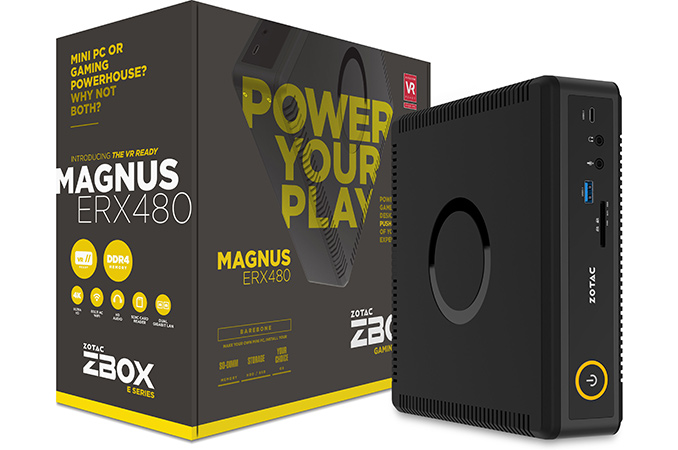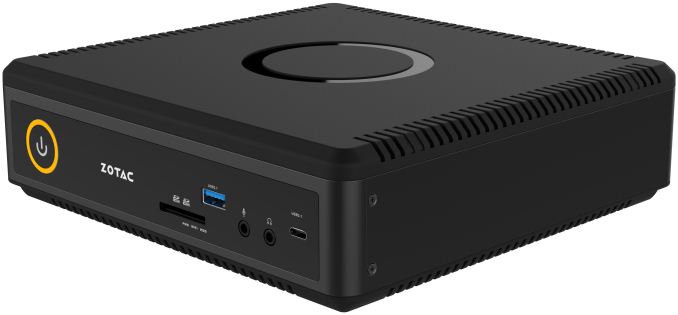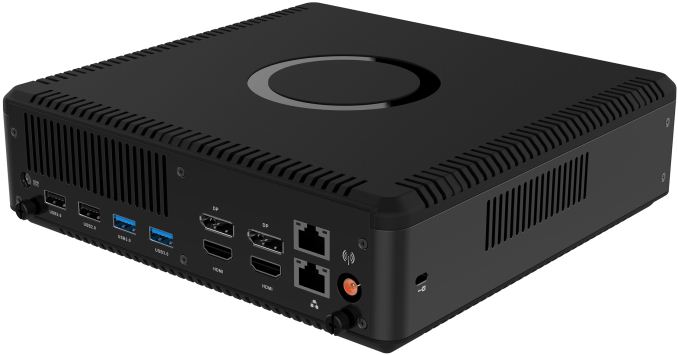ZOTAC ZBOX MAGNUS ERX480: SFF PC with Intel Core i5, AMD Radeon RX480, USB-C
by Anton Shilov on November 4, 2016 8:00 AM EST
ZOTAC has introduced a new small form-factor system that integrates AMD’s Radeon RX 480 graphics as well as an Intel quad-core Core i5-6400T. The compact PC is designed to drive up to four 4K displays at once and can be used both for gaming as well as for productivity applications that demand multiple monitors. In fact, the manufacturer officially positions the system as an entry-level machine for VR gaming.
The ZOTAC ZBOX MAGNUS ERX480 PC is powered by Intel’s Core i5-6400T processor (4C/4T, 2.2 GHz/2.8 GHz, 6 MB LLC cache, 35 W TDP) as well as a custom LGA1151 motherboard with two slots for DDR4-2133 SO-DIMM memory. AMD’s Radeon RX480 MXM module, one M.2-2280 slot for a SATA SSD, a SATA connector, two Gigabit Ethernet controllers, a 802.11ac Wi-Fi/BT 4.2 module and a USB 3.1 controller make up the other key features.
When it comes to connectivity, the ZBOX MAGNUS ERX480 is an example of reasonable set of I/O ports. The system features two HDMI 2.0, two DisplayPort 1.3, two GbE, two 3.5mm audio, two USB 3.0, two USB 2.0, one USB 3.1 Gen 2 Type-A and one USB 3.1 Gen 2 Type-C connectors. In addition, the PC has a 3-in-1 card reader (SD/SDHC/SDXC UHS II). Users with 5.1- or 7.1-channel speaker systems will have to use an external USB audio solution however.
From performance point of view, the ZBOX MAGNUS ERX480 meets the minimum requirements that Oculus VR set for games compatible with the Oculus Rift VR headset back in the first half of 2015: it has a quad-core CPU along with AMD’s Radeon RX 480 GPU, supports up to 32 GB of DDR4 memory and can be equipped with 2 drives (1x M.2 and 1x 2.5"). If game developers follow recommendations of Oculus VR, the MAGNUS ERX480 should run VR titles for Oculus VR with decent framerate.
| ZOTAC ZBOX MAGNUS ERX480 Specifications | |||
| ZBOX MAGNUS ERX480 (barebones) |
ZBOX MAGNUS ERX480 PLUS (w/ DRAM+M.2) |
ZBOX MAGNUS ERX480 WINDOWS (w/ DRAM+M.2) |
|
| CPU | Intel Core i5-6400T (4 cores, 2.2 GHz/2.8 GHz, 6 MB LLC, 35 W) | ||
| PCH | unknown 100-series | ||
| Graphics | AMD Radeon RX480 at 1050 MHz: 2304 stream processors 144 texture units 32 ROPs 256-bit memory interface 4 GB of GDDR5 7 GT/s memory |
||
| Memory | Two SO-DIMM slots, up to 32 GB of DDR4-2133 | 8 GB of DDR4-2133 (one module) | |
| Storage | M.2 SATA 1x SATA 6 Gbps 2.5" |
120 GB M.2 SATA SSD 1 TB 2.5" HDD |
|
| Wi-Fi | 802.11ac + BT 4.2 | ||
| Ethernet | Two Gigabit Ethernet with RJ45 connector | ||
| Display Outputs | 2 × HDMI 2.0 2 × DisplayPort 1.2 |
||
| Audio | 3.5 mm audio in and audio out | ||
| USB | 2 × USB 2.0 Type-A (480 Mbps) 2 × USB 3.0 Type-A (5 Gbps) 1 × USB 3.1 Type-A (10 Gbps) 1 × USB 3.1 Type-C (10 Gbps) |
||
| Other I/O | 3-in-1 card reader (SD/SDHC/SDXC UHS II) | ||
| Dimensions | 210 mm × 203 mm × 62.2 mm 8.27 × 7.99 × 2.45 inches |
||
| PSU | External | ||
| OS | - | Windows 10 Home | |
Speaking of dimensions, it should be noted that like other MAGNUS-series PCs, the ERX480 is not as tiny as Intel’s NUC, but it is not as large as some other models in Zotac's lineup. The relatively small size of the new compact PC from ZOTAC is a result of the company’s decision to use relatively low-power components (the manufacturer claims that the power draw of the ERX480 is 160 W) and air-cooling. We do not know whether the PC gets noisy under high loads, but this is a possibility as the system uses two blowers.
ZOTAC traditionally plans to offer three versions of the MAGNUS ERX480: a barebones with just the CPU and GPU installed; a Plus version with a 8 GB DDR4 memory module, a 120 GB SATA M.2 SSD as well as 1 TB HDD; and a Windows edition with DRAM, storage and Windows 10 Home operating system pre-installed. The manufacturer does not disclose its MSRPs at this time, but claims that all the PCs will be available by the end of November.
Related Reading:
Source: ZOTAC


















29 Comments
View All Comments
hojnikb - Friday, November 4, 2016 - link
Any word on when zotac will refresh it's passive mini PCs with kaby lake ?lmcd - Friday, November 4, 2016 - link
Looks like this particular 480 is notably underclocked compared to retail cards. The question though is whether that underclocking is cautionary or reckless (not enough thermal relief).Makes me regret my Skull Canyon, slightly.
TheinsanegamerN - Friday, November 4, 2016 - link
It could be the mobile varient of the 480, which would be clocked lower and binned higher for lower power consumption.People on forums have underclocked the 480 to dramatically drop it's TDP. People running the 480 at 1100MHz have cut significant voltage off of the chip, reducing it to sub 100 watt TDP in some cases.
This may be what zotac did here.
TheinsanegamerN - Friday, November 4, 2016 - link
*1000mhz, not 1100philehidiot - Friday, November 4, 2016 - link
The other question is of course if the desktop 480 hit the bare minimum requirements for VR, does this variant with the lower clock speed mean this that VR performance is compromised? I know they're saying it does, but then the question becomes throttling - are they testing the components using VR in an open enclosure or in the real chassis? Or has it been tested properly with VR at all? Are they just taking components which themselves are rated for VR and then putting a stamp on it without testing how the system performs? I'd honestly be very cautious about buying something like this and expecting decent VR performance, especially if they're having to mess with clock speeds to keep within the thermal envelope.TheinsanegamerN - Friday, November 4, 2016 - link
true, although a stock desktop 480 also throttles pretty badly in some cases. it was also memory bandwidth bottlenecked IIRC, so that lower clock rate may not do as much harm as it would other cards.It also depends on resolution and graphical quality. You can run VR on a 470 with some sliders turned down, the 480 underclocked should still work pretty well.
lmcd - Friday, November 4, 2016 - link
I think the real thing to emphasize though is how much the Gigabyte BRIX from a recent Anandtech review struggled in spite of its far-superior cooling system. I can't see this system fairing better.Not to say that the Brix ran into real struggles, but it was an appropriate amount of cooling. With a lower-TDP chip and what appears to be a much better cooling design in the same volume, I'd say this Zotac is probably in trouble.
Death666Angel - Friday, November 4, 2016 - link
"[...]Gigabyte BRIX from a recent Anandtech review struggled [...]"You mean the GTX950/i7-6700HQ one? Where did that struggle? It ran the CPU @ 3.1GHz, above base clock and the GPU @ 1024 continuously, no throttling. The test even said:
"It is heartening to note that the thermal design is indeed very effective even in our unnatural power-virus test."
deksman2 - Monday, December 26, 2016 - link
They seemed to have reduced the GPU's frequency to 1050 MHz.Other than that, the GPU seems to be the regular desktop version.
The mobile version of 480 is known as E9550 and does not differ from the desktop in anything, except TDP (which has been cut down to about 95W).
This was probably achieved through tighter quality controls and voltage reduction without sacrificing performance.
However, underclocking is not the only route to reducing the GPU's TDP.
By properly using Wattman feature in Crimson drivers, the 480's voltages can be effectively reduced to result in 120 W (1060 levels, or lower) under full load without reducing it's operational clocks at all.
This was achieved by only reducing highest core voltage setting. The VRAM can also be undervolted (in some cases reportedly by as much as half).
Here's the relevant article:
http://www.legitreviews.com/amd-radeon-rx-480-unde...
The 480's performance also goes up by around 5% in some cases because the boost clocks can be sustained for far longer periods of time.
Also, as you factor in new drivers release... coupled with undervolting, the 480 is now on the same level as 1060 performance/TDP-wise in DX11 and overshoots it in DX12 more or less.
Also to keep in mind is that 480 is working on much lower clocks than 1060 does.
Reference models of RX 480 have been set with too high voltages to improve yields, but subsequent releases of 480 from other vendors resulted in lower voltages out of the box.
That of course doesn't mean we cannot use Wattman to further improve upon 480 without dropping its performance.
So, I find Zotac's version quite underwhelming to be honest.
BrokenCrayons - Friday, November 4, 2016 - link
Interesting system, but I never liked the idea of companies using CGI renders of their products instead of photos of the actual item in their announcements and promotional materials. You really only get a vague sense of the product's look and feel. It's excusable in Zotac's case because the company has, I think, a pretty solid reputation for delivering on their promises, but still...meh